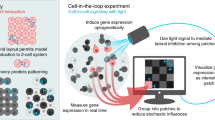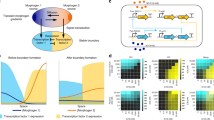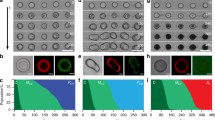Abstract
Pattern formation is a hallmark of coordinated cell behaviour in both single and multicellular organisms1,2,3. It typically involves cell–cell communication and intracellular signal processing. Here we show a synthetic multicellular system in which genetically engineered ‘receiver’ cells are programmed to form ring-like patterns of differentiation based on chemical gradients of an acyl-homoserine lactone (AHL) signal that is synthesized by ‘sender’ cells. In receiver cells, ‘band-detect’ gene networks respond to user-defined ranges of AHL concentrations. By fusing different fluorescent proteins as outputs of network variants, an initially undifferentiated ‘lawn’ of receivers is engineered to form a bullseye pattern around a sender colony. Other patterns, such as ellipses and clovers, are achieved by placing senders in different configurations. Experimental and theoretical analyses reveal which kinetic parameters most significantly affect ring development over time. Construction and study of such synthetic multicellular systems can improve our quantitative understanding of naturally occurring developmental processes and may foster applications in tissue engineering, biomaterial fabrication and biosensing.
This is a preview of subscription content, access via your institution
Access options
Subscribe to this journal
Receive 51 print issues and online access
$199.00 per year
only $3.90 per issue
Buy this article
- Purchase on Springer Link
- Instant access to full article PDF
Prices may be subject to local taxes which are calculated during checkout





Similar content being viewed by others
References
Golden, J. & Yoon, H. Heterocyst formation in anabaena . Curr. Opin. Microbiol. 1, 623–629 (1998)
Scherrer, R. & Shull, V. Structure, partial elemental composition, and size of Thiopedia rosea cells and platelets. Can. J. Microbiol. 32, 607–610 (1986)
Ben-Jacob, E. et al. Cooperative formation of chiral patterns during growth of bacterial colonies. Phys. Rev. Lett. 75, 2899–2902 (1995)
Fuqua, W. C., Winans, S. & Greenberg, E. P. Quorum sensing in bacteria: The luxR-luxI family of cell density-responsive transcriptional regulators. J. Bacteriol. 1760, 269–275 (1994)
Bassler, B. L. How bacteria talk to each other: regulation of gene expression by quorum sensing. Curr. Opin. Microbiol. 2, 582–587 (1999)
Milo, R. et al. Network motifs: simple building blocks of complex networks. Science 298, 824–827 (2002)
Collins, C. H., Arnold, F. H. & Leadbetter, J. R. Directed evolution of Vibrio fischeri LuxR for increased sensitivity to a broad spectrum of acyl-homoserine lactones. Mol. Microbiol. 55, 712–723 (2005)
Jaeger, J. et al. Dynamical analysis of regulatory interactions in the gap gene system of Drosophila melanogaster . Genetics 167, 1721–1737 (2004)
Jaeger, J. et al. Dynamic control of positional information in the early Drosophila embryo. Nature 430, 368–371 (2004)
Weiss, R. & Knight, T. F. Jr in DNA6: Sixth International Workshop on DNA-Based Computers, DNA2000 (eds Condon, A. & Rozenberg, G.) 1–16 (Springer, Leiden, The Netherlands, 2000)
Ptashne, M. A Genetic Switch: Phage Lambda and Higher Organisms, 2nd edn (Cell Press and Blackwell Scientific Publications, Cambridge, Massachusetts, 1986)
Egland, K. A. & Greenberg, E. P. Quorum sensing in Vibrio fischeri: elements of the luxI promoter. Mol. Microbiol. 31, 1197–1204 (1999)
Weiss, R. & Basu, S. in NSC-1: The First Workshop of Non Silicon Computinghttp://www-2.cs.cmu.edu/ ∼phoenix/nsc1/paper/3-2.pdf (2002).
Basu, S., Mehreja, R., Thiberge, S., Chen, M. & Weiss, R. Spatiotemporal control of gene expression with pulse-generating networks. Proc. Natl Acad. Sci. USA 101, 6355–6360 (2004)
Weiss, R. Cellular Computation and Communication Using Engineered Genetic Regulatory Networks. Ph.D. thesis, Massachusetts Inst. Technology (2001)
Andersen, J. B. et al. New unstable variants of green fluorescent protein for studies of transient gene expression in bacteria. Appl. Environ. Microbiol. 64, 2240–2246 (1998)
Choi, S. H. & Greenberg, E. P. Genetic evidence for multimerization of LuxR, the transcriptional activator of Vibrio fischeri luminescence. Mol. Mar. Biol. Biotechnol. 6, 408–413 (1992)
Yates, E. A. et al. N-acylhomoserine lactones undergo lactonolysis in a pH-, temperature-, and acyl chain length-dependent manner during growth of Yersinia pseudotuberculosis and Pseudomonas aeruginosa . Infect. Immun. 70, 5635–5646 (2002)
Acknowledgements
We thank D. Karig, S. Hooshangi, S. Thiberge, M.-T. Chen and S. Subramaniam for discussions or comments on the manuscript. This material is based on work supported by the Defense Advanced Research Projects Agency (DARPA).
Author information
Authors and Affiliations
Corresponding author
Ethics declarations
Competing interests
The authors declare that they have no competing financial interests.
Supplementary information
Supplementary Notes
This file contains Supplementary Table S1, which lists the high-detect, low-detect, sender, and marker plasmids used in this study. It also contains Supplementary Figure S1, which presents a contour map of band-detect gain as a function of LacI and CI repression efficiency; and Supplementary Figure S2, which details surface maps for BD2-Red and BD3 fluorescence intensities. (PDF 265 kb)
Rights and permissions
About this article
Cite this article
Basu, S., Gerchman, Y., Collins, C. et al. A synthetic multicellular system for programmed pattern formation. Nature 434, 1130–1134 (2005). https://doi.org/10.1038/nature03461
Received:
Accepted:
Issue Date:
DOI: https://doi.org/10.1038/nature03461
This article is cited by
-
Nuclear receptor NURR1 functions to promote stemness and epithelial-mesenchymal transition in prostate cancer via its targeting of Wnt/β-catenin signaling pathway
Cell Death & Disease (2024)
-
Spatial biology of Ising-like synthetic genetic networks
BMC Biology (2023)
-
Engineered bacterial swarm patterns as spatial records of environmental inputs
Nature Chemical Biology (2023)
-
Protein-based bandpass filters for controlling cellular signaling with chemical inputs
Nature Chemical Biology (2023)
-
Engineering the gut microbiome
Nature Reviews Bioengineering (2023)
Comments
By submitting a comment you agree to abide by our Terms and Community Guidelines. If you find something abusive or that does not comply with our terms or guidelines please flag it as inappropriate.



